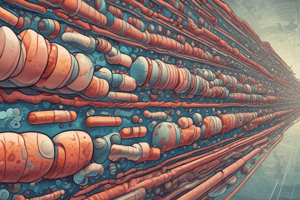Podcast
Questions and Answers
Which of the following is true about aminoglycosides?
Which of the following is true about aminoglycosides?
- They are bacteriostatic
- They are primarily effective against gram positive organisms (correct)
- They inhibit the 50S portion of the 30S mRNA
- They have excellent oral absorption
What is the mechanism of action of aminoglycosides?
What is the mechanism of action of aminoglycosides?
- Inhibition of protein synthesis (correct)
- Inhibition of DNA replication
- Inhibition of cell wall synthesis
- Inhibition of RNA transcription
Which of the following is NOT a drug within the aminoglycoside class?
Which of the following is NOT a drug within the aminoglycoside class?
- Vancomycin (correct)
- Gentamicin
- Amikacin
- Tobramycin
What is the peak concentration over minimum inhibitory concentration (Cp/MIC) the pharmacodynamic parameter for aminoglycosides?
What is the peak concentration over minimum inhibitory concentration (Cp/MIC) the pharmacodynamic parameter for aminoglycosides?
What is the absorption of aminoglycosides when taken orally?
What is the absorption of aminoglycosides when taken orally?
Which of the following is true about the distribution of aminoglycosides?
Which of the following is true about the distribution of aminoglycosides?
What is the supplemental mode of action of aminoglycosides?
What is the supplemental mode of action of aminoglycosides?
Which of the following is NOT a characteristic of aminoglycosides?
Which of the following is NOT a characteristic of aminoglycosides?
How are aminoglycosides generally infused when administered intravenously?
How are aminoglycosides generally infused when administered intravenously?
What is the spectrum of activity of aminoglycosides?
What is the spectrum of activity of aminoglycosides?
Which dosing strategy optimizes the pharmacodynamics of the drug by taking advantage of the post-antibiotic effect (PAE) and decreases the risk for toxicity?
Which dosing strategy optimizes the pharmacodynamics of the drug by taking advantage of the post-antibiotic effect (PAE) and decreases the risk for toxicity?
When is therapeutic drug monitoring (TDM) always necessary with aminoglycosides (AG)?
When is therapeutic drug monitoring (TDM) always necessary with aminoglycosides (AG)?
What is the goal level for the trough concentration (Ctr) of aminoglycosides (AG) during traditional dosing?
What is the goal level for the trough concentration (Ctr) of aminoglycosides (AG) during traditional dosing?
What is the recommended timing for peak and trough level monitoring during traditional dosing?
What is the recommended timing for peak and trough level monitoring during traditional dosing?
What is the maximum creatinine clearance (CrCl) value used in the dosing calculations for aminoglycosides (AG)?
What is the maximum creatinine clearance (CrCl) value used in the dosing calculations for aminoglycosides (AG)?
Which dosing strategy is indicated when patient-specific pharmacokinetic (PK) data is not available?
Which dosing strategy is indicated when patient-specific pharmacokinetic (PK) data is not available?
What is the goal level for the peak concentration (Cpk) of aminoglycosides (AG) during traditional dosing?
What is the goal level for the peak concentration (Cpk) of aminoglycosides (AG) during traditional dosing?
Which dosing strategy uses the Hartford Nomogram to adjust the frequency of aminoglycoside (AG) dosing?
Which dosing strategy uses the Hartford Nomogram to adjust the frequency of aminoglycoside (AG) dosing?
What is the recommended timing for random level monitoring during extended interval dosing?
What is the recommended timing for random level monitoring during extended interval dosing?
What is the recommended timing for drug infusion times of gentamicin, tobramycin, and amikacin during traditional dosing?
What is the recommended timing for drug infusion times of gentamicin, tobramycin, and amikacin during traditional dosing?
Flashcards are hidden until you start studying
Study Notes
Aminoglycosides
- The mechanism of action of aminoglycosides involves inhibiting bacterial protein synthesis by binding to the 30S ribosomal subunit.
Pharmacodynamics
- The pharmacodynamic parameter for aminoglycosides is the peak concentration over minimum inhibitory concentration (Cp/MIC).
- The post-antibiotic effect (PAE) is a supplemental mode of action of aminoglycosides.
Pharmacokinetics
- Aminoglycosides are poorly absorbed when taken orally.
- Aminoglycosides are distributed in extracellular fluids, which is important for their antibacterial effect.
Administration
- Aminoglycosides are generally infused over 30 minutes to 1 hour when administered intravenously.
Spectrum of Activity
- Aminoglycosides have a broad spectrum of activity against aerobic gram-negative bacilli and some gram-positive bacteria.
Dosing Strategies
- The extended interval dosing strategy optimizes the pharmacodynamics of aminoglycosides by taking advantage of the post-antibiotic effect (PAE) and decreases the risk for toxicity.
- The Hartford Nomogram is used to adjust the frequency of aminoglycoside dosing in the extended interval dosing strategy.
Therapeutic Drug Monitoring (TDM)
- TDM is always necessary with aminoglycosides in patients with impaired renal function, those at high risk for toxicity, and those with changing renal function.
- The goal level for the trough concentration (Ctr) of aminoglycosides during traditional dosing is < 1-2 mg/L.
- The goal level for the peak concentration (Cpk) of aminoglycosides during traditional dosing is 8-10 times the MIC.
- Peak and trough levels should be monitored 30 minutes after infusion and just before the next dose, respectively, during traditional dosing.
- Random level monitoring is recommended during extended interval dosing.
- The maximum creatinine clearance (CrCl) value used in dosing calculations for aminoglycosides is 120 mL/min.
Dosing Calculations
- When patient-specific pharmacokinetic (PK) data is not available, a dosing strategy using a standard dose and interval can be used.
Studying That Suits You
Use AI to generate personalized quizzes and flashcards to suit your learning preferences.




